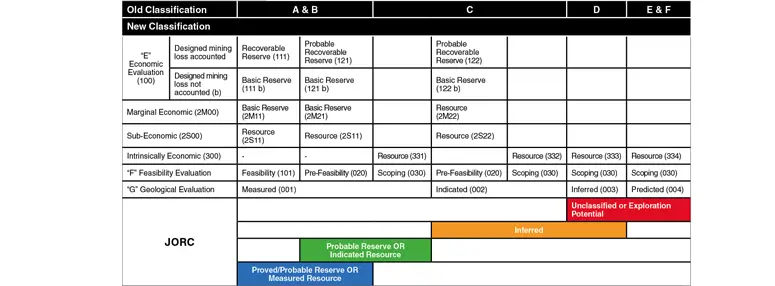SRK has been involved with exploration and mining projects in China since the 1990s, with a strong focus on providing Competent Person’s Reports for stock exchange listings in Hong Kong and London. In addition, much Due Diligence and Fatal Flaw analysis work on Chinese resource projects has been completed, for both western and Chinese companies. Through this work, SRK has found that there are fundamental philosophical and practical differences between the Joint Ore Reserves Committee (JORC) and Chinese resource classification systems.
The system for categorizing mineral resources and ore reserves in China has recently changed. The traditional system (Old), which is derived from the former Soviet system, has been slowly phased out since 1999, and uses categories A through F for resources, based on decreasing levels of geological confidence. The current system (New) uses a three-dimensional matrix based on degrees of confidence in Economic, Feasibility, and Geological evaluations. The resulting classification is categorized by a three number code, and is also allocated either to “Resource” or “Reserve” status. This new system meets the standards of the United Nations Framework Classification, which was proposed for international use in 2004.
All new projects in China must comply with the New system. However, resource estimates and feasibility studies carried out on projects before 1999 used the Old system. As a result, projects with an extended exploration and development history often contain resource and reserve estimates reported under both the Old and the New codes.
These codes can be difficult to reconcile and evaluate, particularly in the absence of any other supporting data on which the resource estimate was based. Given our obligations under JORC and Valmin as members of the AusIMM and/or AIG, the Competent Person must provide a comparison of how JORC non-compliant resource estimates broadly fit the JORC classification categories. Table 1 provides a rule of thumb comparing the Chinese Classifications with JORC (2004), which project evaluation teams can use.
Initially, this rule of thumb comparison can be used during project evaluation, to understand the level of detail that should have been incorporated into the resource estimate. However, any detailed analysis of the resource requires a thorough review of these data before assigning a definitive classification under JORC. If the relevant Chinese Government Authority has signed off on the resource being evaluated, these data should be readily available for review by the evaluation team.

